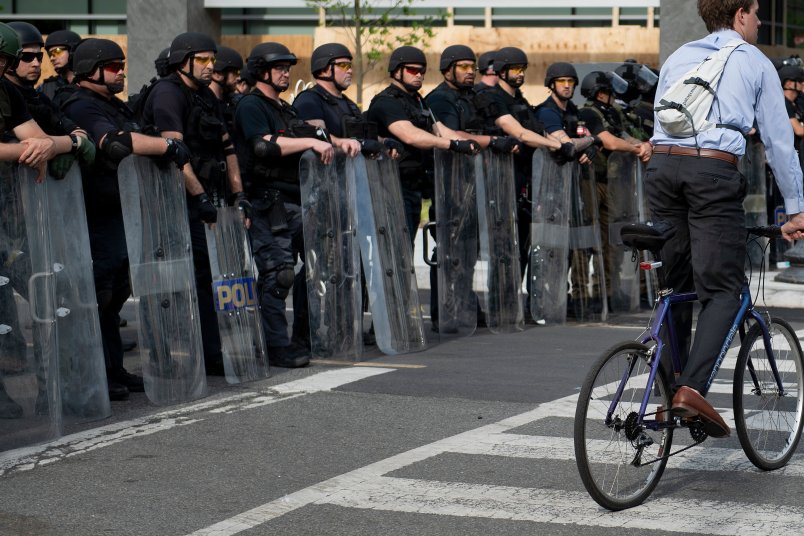Among the alphabet soup of federal law enforcement agencies patrolling the streets of Washington, D.C. in recent days, a deployment of “crisis management” teams from the Federal Bureau of Prisons stuck out like a sore thumb.
That’s because the federal prison guards don’t typically deal with unincarcerated people, let alone protesters calling for an end to police brutality.
And yet, on Wednesday, photos from the demonstrations in D.C. showed men in riot gear on the city’s streets without identifying information on their uniforms. Eventually, the Bureau of Prisons confirmed to MSNBC that the men were “SORT” — Special Operations Response Teams.
Shift change: National guard has been replaced with a different unit. One officer identified himself to protestors as being with “DOJ”, another said he was from California, and one has a Bureau of Prisons patch on his vest. No name plates. pic.twitter.com/QIjNlMTfsQ
— Garrett Haake (@GarrettHaake) June 3, 2020
The show of force was met with extreme skepticism.
“This is a very, very bad idea,” the former Justice Department Inspector General Michael Bromwich said Monday in response to the news that the department was deploying the federal prison riot teams to D.C. and Miami.
“Bureau of Prisons riot teams are trained to deal with disturbances created by convicted criminals in prison facilities, not with protesters on the streets of our cities,” Bromwich said. “These are worlds apart.”
Deborah Golden, an attorney who’s worked for years on federal prisoners’ rights, told TPM that federal prison guards work from a drastically different set of rules than street cops.
“Respecting the rights of people to assemble and petition the government is not something that BOP officers are trained to be as cautious about,” she said. “It would be a sign of incredible danger if you were in a prison and a group of 100 prisoners congregated and started chanting. Any BOP officer would be trained to react immediately to that as a serious situation.”
In prison, incarcerated people know about the obligation to follow officers’ orders, Golden said, such as an order to get down on the ground if something were to happen in an open yard.
“That’s not something that people in Lafayette Park have to obey, and aren’t going to,” she said.
In a letter to Attorney General Bill Barr Thursday, House Speaker Nancy Pelosi (D-CA) sounded the alarm over the “unidentified federal law enforcement personnel” at the nation’s capital, which included the BOP officers.
“We are concerned about the increased militarization and lack of clarity that may increase chaos,” she wrote.
At a press conference Thursday alongside Barr and others, Bureau of Prisons Director Michael Carvajal said federal prison guards were “often called upon to assist during crisis situations within our communities.”
“BOP Crisis Management teams are highly trained to deal with various types of emergency situations, including crowd control and civil disturbances,” he added. “They are experienced in confrontation avoidance and conflict resolution.”
Later Barr said SORT teams were “used frequently for emergency response and in emergency situations in either civil disturbances or hurricanes or other things like that.”
There were at least two uses of BOP personnel in emergency situations when Barr was last attorney general, in the early ‘90s.
Two days after Hurricane Andrew rammed into the state of Florida, “Bureau staff, assisted by the U.S. Marshals Service, had safely transported nearly 1,400 inmates to other Bureau and non-Bureau correctional facilities throughout the Southeast Region,” according to a “State of the Bureau” report for that year.
Also in 1992, Los Angeles experienced an upheaval over the police beating of Rodney King. In response, as the report describes, “20 of the Bureau’s Special Operations Response Teams (SORT’s) from Federal institutions nationwide traveled to the riot-torn area.”
The report describes a chaotic situation, with the special operator prison guards patrolling neighborhoods, searching burned-out buildings, “apprehending four individuals possessing cocaine, preventing an individual from stabbing a woman, and apprehending a sniper who had been shooting at residents.”
As Golden noted, it “doesn’t sound like they were doing protest patrol.”







Because it is a prison riot in the American Battlespace. It seems that the Trump/Barr thinking is that all that lies ahead is violence and upheaval anyway, so why not get a head start? Tear gas, anyone?
This is an opportune time for administration officials to meet their future overseers.
Am I the only one who thinks this looks like Russia’s actions in Ukraine - causing chaos, using unmarked militants, etc. Am I paranoid if I think Putin might have suggested it on one of their recent phone calls? Just sayin’.
If that guy wearing bicycle clips on his trousers and an ergonomically correct backpack on his back
isn’t a criminal, I don’t know who is.
People trained to take down hardened criminals and murderers who have overtaken a prison violently being face-to-face with crowds of normal citizens…
What could possibly go wrong?